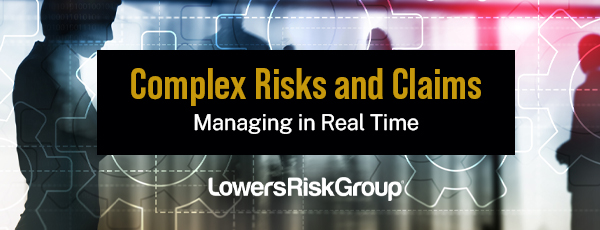The Best Ways to Manage Complex Risks and Claims in Real Time

Managing complex risks and claims requires a proactive blend of technology, flexible processes, practiced behaviors, and collaboration.
For organizations that operate in high-risk, highly regulated environments, having a comprehensive enterprise risk management (ERM) strategy is essential. When an appropriate ERM framework is in place and is being used, businesses are better prepared to achieve their short and long-term objectives because they are able to identify, assess, respond to, and monitor risk.
With the modern pace of business and recent developments in technology such as artificial intelligence (AI), insurance professionals and business leaders from the industrial, commercial, financial, and public-private sectors are looking into more efficient ways of executing their ERM strategy, and it has led them to ask questions about what is possible in real time.
Ahead of RIMS RiskWorld 2023, we asked a panel of subject matter experts that consult for decision-makers around the world in industries like Energy, Mining, Construction, Distribution, Manufacturing, Agriculture, Inland Marine, and Real Estate their thoughts on the best ways to manage complex risk exposures – and their associated claims – in real time.
Panelists

Jon Groussman
President at Lowers & Associates Consulting

Danielle Gardiner
SVP at Lowers Forensics International

Dan Hyman
Director at Lowers Drone Solutions

Andrew Ballard
SVP at Lowers Risk Group
#1 A Culture of Care
Across the board, every panelist agreed that culture is one of the most important parts of managing risk within an enterprise. If an organization believes in round-the-clock risk management, deploying strategies to do so in real-time makes sense. Within a culture of care – care for each other, the business, clients, and quality of work – employees and leadership are empowered to identify and speak up about potential threats to the business and are enabled to do something about it in a strategic, meaningful way.
Pro-Tip: In a high-reliability organizations (HROs) design protocols ensure all employees are aware of the importance of managing risks and are actively involved in identifying and mitigating them.
#2 Strategic Assessments
Comprehensive ERM plans should include the identification of potential risks, including assessments of their likelihood and impact on business operations, finances, and more. Conducting regular surveys, audits, and compliance reviews are just a few examples.
“Whether it’s pre-loss threat and vulnerability or post-loss response and remediation, real-time prevention and response to security must include tools that mitigate crime threats and their associated liabilities, but they must be objective, and have operational feasibility,” Jon Groussman, President of Lowers & Associates Consulting, said. “Strategic assessments are a phenomenal way to identify where security gaps exist in your organization that can lead to avoidable claims.”
Bonus Resource: Preventing Holiday Fraud eBook
#3 Practice Procedure
Assessments alone aren’t enough if the follow-up does not include the development of strategies to mitigate or manage the vulnerabilities identified, however. Standard operating procedures (SOPs) and business continuity plans (BCPs) are necessary to build a framework for risk monitoring and evaluation. The best SOPs and BCPs incorporate analytics and data to build a better defense, or in the case of a loss event, the response and recovery.
“Real-time data can be a powerful tool in analysing and managing risk, but it should run parallel with a robust and flexible risk management framework to be effective,” Andrew Ballard, SVP at Lowers Risk Group, said. “By monitoring key indicators, analyzing structured and unstructured data for trends, using predictive modeling, collaborating with stakeholders, and implementing automated risk tracking systems, organizations can effectively leverage technology to manage risks and minimize their potential impact.”
Solution Spotlight: Risk Concierge by Periculus
Assess, review, and leverage solutions in real-time to mitigate and manage risk, all in one place.
#4 Applied Technology
Technology can be used as a powerful asset to manage complex risks. For example, real-time monitoring and analysis of data can help identify and respond to potential risks more quickly and effectively. Continuous Court Access Monitoring by InformData helps organizations manage their human capital risk, and rapidly evolving UAV/UAS platforms provide ample use cases for drones (especially programs that combine hardware, software, and the cloud, using an insurance-oriented approach).
“Drones enable a more efficient response time, whether its pre-risk (property surveying) or post-event (damage assessments)” Dan Hyman, Director at Lowers Drone Solutions, said. “They also offer a more thorough POV than other airborne assets like manned, fixed, or rotary-wing (while also being more cost-effective). Special camera arrays provide LiDAR, thermal imaging, and many more options that allow insurance professionals to benchmark against potential threats or compare pre-existing data sets in the event of a claim, and the best programs enable clients with real-time access into the data and its many layers for analysis of 3D models, orthomosaics, and more.”
Quick Reference Guide: From the Top Down – How to Use Drones and Data to Manage Risk
#5 Communication & Collaboration
From developing an early warning system to deploying contingency plans in managing the next phase of recovery, communication, and collaboration between teams of people (employees, suppliers, customers, regulators) is an essential component of ERM –to manage complex risks in real-time. The ability to work through complex risks and their associated claims strategically and systematically is a practiced skill that, when done correctly, builds trust and fosters a shared commitment to successful risk management strategies.
“When it comes to calculating Business Interruption claims from CAT events, such as a hurricane, every forensic accountant should be recommending to their clients how they can mitigate future damages when they hand in their report,” Danielle Gardiner, SVP at Lowers Forensics International, said. “Our job might be to examine the financial impact of an event, but in our investigation, it always becomes clear who was prepared and who was not. Oftentimes, the breakdowns occur pre-event because there is not an established chain of command or platform to collaborate easily.”
Solution Spotlight: Stratis
Overall, the challenges of managing complex risks in real time require a proactive and adaptive approach that involves continuous monitoring and analysis, with a collaborative response. By developing a culture of care, utilizing strategic assessments, having regular procedural training, applying the appropriate technology, and fostering communication and collaboration, organizations can effectively mitigate risks and minimize the potential impact of claims.
At Lowers Risk Group, our ecosystem of businesses, consultants, and supporting technology provides a single point of contact to help organizations manage these complex challenges. For over 40 years, we have helped high-reliability organizations be capable of mitigating, managing, and resolving uncertainty in order to build brighter, more resilient futures for themselves and those they serve.
Have questions? Let’s start a conversation.